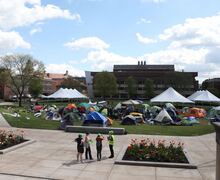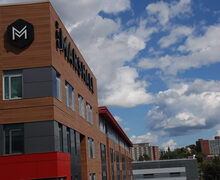Shroom with a view: Architecture senior builds model with mushrooms
Leanne Rivera | Staff Photographer
Merry’s hemp rope and mycelium installation was presented on Monday in Slocum Hall. She and her team have been working on the project since February.
Get the latest Syracuse news delivered right to your inbox.
Subscribe to our newsletter here.
Jenna Merry never expected to be spending any time in a lab working with mushrooms. To Merry’s surprise, the lab became an escape from her typical work and the place where she’d learn to “harness the living” and create her final thesis project.
“Working in the lab became something that was peaceful to just go there and mix stuff up,” said Merry, a fifth year architecture student. “Most of my architectural career, I stare at a screen and I make drawings. But this was a way to unplug and do something very hands-on.”
Merry has spent the last semester creating her final architecture thesis project: a hanging installation made up of mycelium, the root-like structures of mushrooms, and hemp ropes. The installation had its one-day showcase in Slocum Hall on Monday, hanging in the atrium of the building and stretching around 7 feet wide and 16 feet long.
Unlike typical thesis projects, made up of materials like wood or concrete, Merry made hers out of biomaterial, which Merry said have a low impact on the environment. She said she’ll always be an advocate for including them, or other environmentally friendly solutions, into the architecture industry when she graduates.
“Because buildings themselves and construction work have one of the highest, if not the highest, impact rates on the planet, I wanted to kind of talk about it in a way of, ‘oh, it doesn’t have to be,’” said Merry. “It can be made out of mushrooms, and it can be just as significant and just as useful as concrete or wood or glass.”
She began exploring the science behind mushrooms in January 2022 when School of Architecture professor Nina Sharifi offered her the opportunity to become a research assistant at a lab in the Syracuse Center of Excellence. Merry assisted in mixing and assembling the mycelium that her professor would then observe and use for research.
The mixing process started with a bag of mycelium, which Merry compared to a bag of mulch. She took the bags of mycelium and mixed them with flour, distilled water and coffee grounds for the mushroom to feed off of. Afterwards, Merry said that she took this mixture and let it sit in a contained, dark space for roughly five to six days because fungi grow best in dark areas. From there, Merry took the mycelium and put it in an oven to bake to prevent any further growth.
“The process is kind of like baking a cake,” Merry said. “You put in all your ingredients, you mix it up and then you put it in a cake pan.”
For her project, Merry used the same process, but before creating the mycelium mixtures, she would crochet together ropes made out of hemp for the mycelium to grow on. By doing this, the hemp ropes would manipulate the shape and growth of the mycelium into what Merry wanted.
Merry initially learned how to crochet in an honors class at SU called Crocheting for the Community. Prior to that class, she didn’t have any experience with crocheting but soon fell in love with it. The process of creating the intricate loops and pockets made Merry think about the potential opportunity to use this technique in her thesis project.

In her installation, Jenna Merry included a poster of her creative process. The poster shows close-ups and faraway pictures of the pieces of her installation. Leanne Rivera | Staff Photographer
“So through that class, I went from knowing absolutely nothing to then making all of these things and I noticed over time, the way that a crochet loop looks kind of like a pocket, it got me thinking that it would actually be a good little pocket to place mycelium inside.”
From there, Merry began researching how mycelium grows on a microscopic level and decided that the hemp rope would be a great, natural material for the fungi to grow on.
After baking the mycelium on the hemp ropes, the fungi takes on a sturdy texture that makes it fit for architectural uses like insulation and building materials. A few other architecture students worked as Merry’s thesis assistants by helping with the crocheting process. Merry and her assistants began constructing the actual installation in February and just recently finished it this past week.
Isabella Bai, an undergraduate student in the architecture program, said she hadn’t worked on a project like this before.
“I often work with traditional architectural materials or model making but working with mycelium is definitely unique,” said Bai. “I’ve never worked with a material that requires growth and is so free in scale and form.”
With that freedom, mycelium offers a wide range of potential. Merry said it also made it tricky because sometimes, the fungi wouldn’t grow exactly how she wanted or at all. When outside pollutants like bacteria get introduced into the growing environment, it can impede the growing process.
All of these different factors were things that architecture student Catherin Kovalcik hadn’t used in her architecture work before.
“I originally volunteered to help Jenna because I’ve crocheted and I thought it would be fun to learn more about mycelium and its connection to architecture,” Kovalcik said.
Though moving architecture in sustainable directions is incredibly important to Merry, she understands that actually making that happen isn’t as easy as it seems.
“It’s a slow process,” Merry said, “and obviously we want to make giant leaps in every direction, but baby steps are the best that we can ask for right now.”
Published on April 24, 2023 at 8:20 pm





